促進寶寶的感官發展:從新生兒到一年的綜合指南
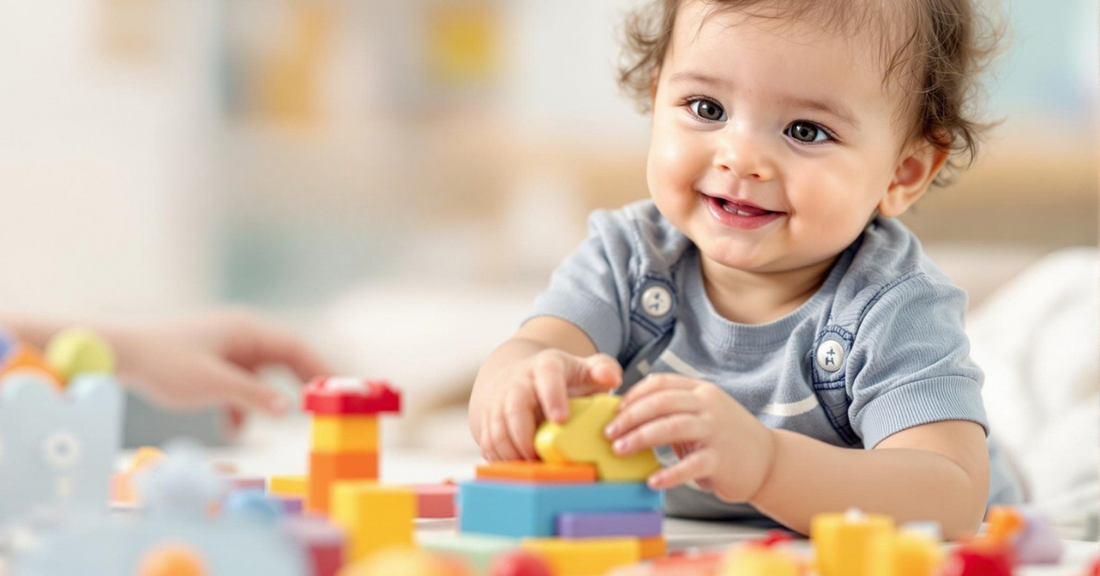
從出生開始,感官經驗就構成了理解世界和培養學習技能的基礎。本文詳細描述了新生兒、3個月、6個月和12個月階段的感官發展特點,並提供了豐富的互動遊戲和安全玩具的建議,同時強調了父母在陪伴和引導寶寶感官發展方面的關鍵作用。
促進寶寶感官發展:從新生兒到一歲寶寶的綜合指南
從來到這個世界的那一刻起,嬰兒就開始了一段不可思議的探索之旅。他們的感官發展——包括聽覺、味覺、視覺和觸覺——是理解環境和培養以後語言、認知和社交互動技能的基礎。本指南探討如何在各個階段支持寶寶的感官成長,以及實用的遊戲技巧和玩具建議。
目錄
了解基本感官發育
- 聽力
新生兒對低音調的聲音較敏感。大約六個月時,它們就能分辨出各種聲音頻率。簡單的互動玩具,如撥浪鼓或風鈴,可以幫助您的寶寶將聲音與物體聯繫起來,從而培養他們的聽覺技能。 - 品嚐
在妊娠晚期,味覺開始在子宮內發育。出生時,嬰兒就能辨識甜、酸、苦的味道。到四個月時,鹹味已融入孩子不斷增長的感官中。早期的餵食經歷,無論是透過母乳還是奶瓶,都為以後的味覺探索奠定了基礎,尤其是當固體食物引入新口味時。 - 想像
出生時, 嬰兒的視力有限。最初,他們在黑色、白色和紅色等高對比度的顏色中看得最清楚。隨著時間的推移,隨著他們的視力發育,大約四個月時他們開始注意到黃色、綠色、橙色,最後是藍色。雖然新生兒受益於高對比度的圖像,但較大的嬰兒透過動態和互動玩具接觸全色譜時會茁壯成長。 - 觸碰
觸覺是出生時最發達的感覺。嬰兒透過抓握和咬住物品來探索世界。具有各種紋理且易於小手握住的玩具可以鼓勵感官探索並幫助發展精細運動技能。

發展階段和感官遊戲技巧
新生兒(0-3個月)
- 聽力:
即使在最初的日子裡,嬰兒也是專注的傾聽者。用撥浪鼓或輕輕搖晃玩具發出的簡單聲音可以幫助他們將聽覺提示與運動聯繫起來。
玩法提示: 發出柔和、重複的聲音,並觀察寶寶如何用眼睛和頭部跟隨這些聲音。 - 品嚐:
新生兒本能地用嘴巴進行探索。餵食時間提供了主要的味覺體驗,而口腔活動則有助於發展早期的口腔運動技能。
玩法提示: 提供安全、柔軟的物體,讓寶寶輕輕地含在嘴裡,以了解質地和味道。 - 想像:
由於視力有限(只能聚焦在 8-12 英寸左右),新生兒對高對比圖案和簡單形狀的反應最佳。
玩法提示: 在寶寶俯臥時使用落地鏡或感官面板,讓寶寶可以觀察自己的倒影和高對比影像。 - 觸碰:
抓握是新生兒最早的反應之一,有助於觸覺探索。
玩法提示: 提供易於小手抓握的紋理玩具,鼓勵寶寶用手和嘴巴進行探索。
3個月時
- 聽力:
嬰兒開始辨識聲音並模仿簡單的聲音。
玩法提示: 大聲朗讀、唱歌並使用有節奏的聲音來提高聽覺識別和早期語言技能。 - 品嚐:
隨著第一顆牙齒開始長出(通常在三個月後),出牙就成為一種新的感官體驗。
玩法提示: 引入冰鎮牙膠或質地柔軟的玩具,可以舒緩牙齦疼痛,同時透過輕柔咀嚼提供味覺體驗。 - 想像:
隨著視覺能力的提高,嬰兒開始區分各種顏色。
玩法提示: 讓您的寶寶玩著五顏六色的玩具和圖畫書來促進視覺發展。 - 觸碰:
嬰兒逐漸形成了將物體從一隻手轉移到另一隻手的能力,並主動探索不同的質地。
玩法提示: 透過在孩子伸手可及的地方放置有趣的玩具來鼓勵他們伸手抓取 俯臥時間。
6個月時
- 聽力:
到六個月大的時候,嬰兒開始對更廣泛的聲音著迷。
玩法提示: 提供能發出不同聲音的玩具;這不僅能娛樂他們,還能幫助他們提升聽覺辨別能力。 - 品嚐:
隨著口腔探索的不斷進行,引入安全、可食用的固體食物可以補充他們不斷發展的味覺。
玩法提示: 開始用手指餵食時,請密切觀察以確保進行安全且有趣的感官探索。 - 想像:
嬰兒現在對運動和光線很感興趣。他們追蹤和聚焦移動物體的能力是一個重要的里程碑。
玩法提示: 使用將運動與鮮豔色彩結合的發光或旋轉玩具來吸引和教育孩子。 - 觸碰:
隨著鉗子抓握能力的發育,嬰兒現在可以主動拿起小物體來檢查其質地和形狀。
玩法提示: 提供各種有紋理的玩具,不僅鼓勵探索,還鼓勵手眼協調。
12個月時
- 聽力:
大約一歲時,嬰兒開始將聲音與現實世界的物體和經驗聯繫起來。
玩法提示: 讓他們參與簡單的音樂創作活動,例如拍手或隨著旋律跳舞,以加強聽覺連結。 - 品嚐:
儘管一歲的孩子仍然習慣於熟悉的味道,但他們開始欣賞將學習與安全咀嚼功能相結合的產品中更複雜的感官遊戲。
玩法提示: 推出既可用作牙膠又可用作學習玩具的互動遊戲套裝。 - 想像:
此階段的嬰兒擁有接近成人的視力,能夠辨識詳細的圖案並建立因果關係。
玩法提示: 選擇包含堆疊和分類等兩步驟動作的玩具來刺激他們蓬勃發展的認知技能。 - 觸碰:
精細運動技能正在快速發展。涉及堆疊、分類或移動物體的活動有助於認知和身體發育。
玩法提示: 鼓勵孩子們透過需要精確度和探索性的拼圖、積木和分類遊戲來發揮想像力。
選擇合適的感官玩具
選擇適合年齡的感官玩具是孩子成長歷程的關鍵。以下是一些建議:
- 對於新生兒:
選擇 高對比的玩具 影像、簡單的聲音效果以及多種紋理,方便安全地咬合和抓握。 - 3至6個月:
選擇柔軟、多彩的玩具,如撥浪鼓、牙膠和互動面板,以促進視覺和觸覺探索。 - 12個月時:
尋找將因果關係與動手遊戲結合的玩具,例如 堆疊玩具 和分類套裝-培養寶寶的分析能力和創造力。
父母在感官發展中的作用
父母的參與對於培養感官發展至關重要:
- 互動交流:
定期與寶寶說話、唱歌和閱讀。透過眼神交流和輕柔的手勢進行密切的互動可以增強安全感並鼓勵學習。 - 創造安全的探索環境:
讓您的寶寶自由安全地探索。精心佈置的遊樂區配有適合年齡的玩具,支援孩子獨立探索和有指導的探索。 - 適應和旋轉刺激:
隨著寶寶的成長,改變感官刺激的類型。定期引入新的紋理、顏色和聲音可以使環境變得豐富和有趣。
總之
感官發展是嬰兒學習之旅的基石。透過了解和培養從新生兒到一歲每個階段的聽覺、味覺、視覺和觸覺的發展,父母可以顯著增強孩子與世界互動的能力。透過精心挑選的玩具和充足的有趣的遊戲時間,您可以為寶寶創造無數的探索、學習和成長的機會。
本文旨在為希望支持寶寶感官發展並享受珍貴的玩耍和探索時刻的父母提供有用的指南。
Charlotte Taylor is Tumama’s Assistant Editor, where she brings her passion for early childhood development and the perinatal period, plus experience as a mom of two to Tumama articles and guides. She’s also a certified lactation counselor. A former preschool teacher, she loves children’s picture books, cats, plants and making things.
相關網誌

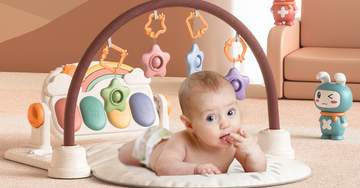


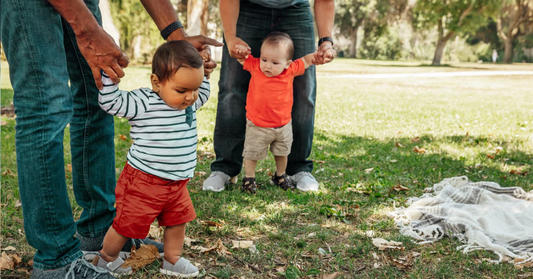
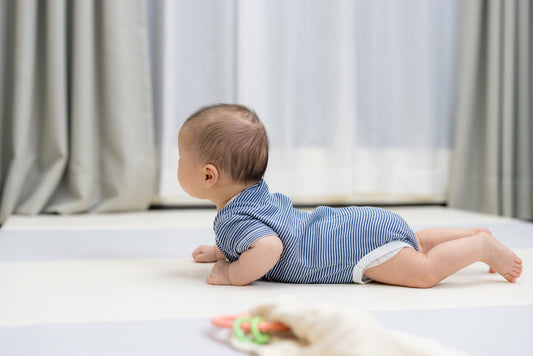
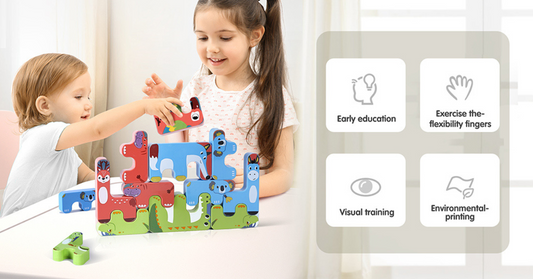
0評論